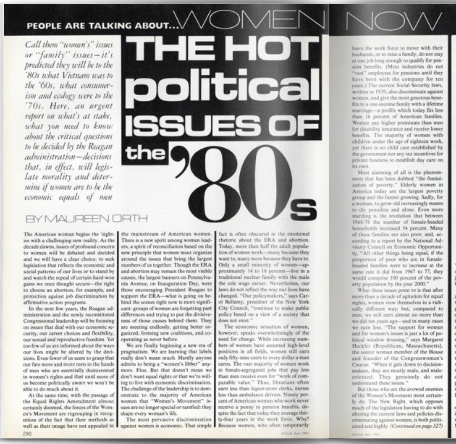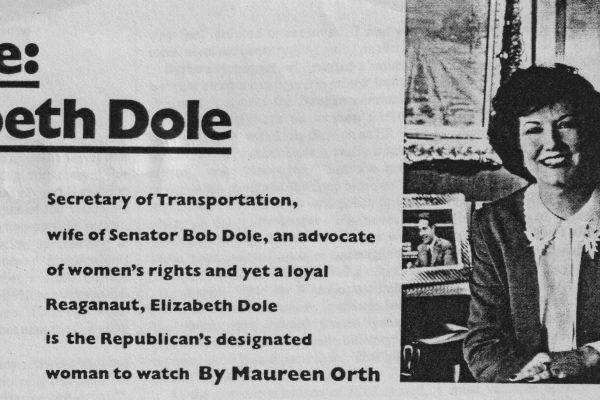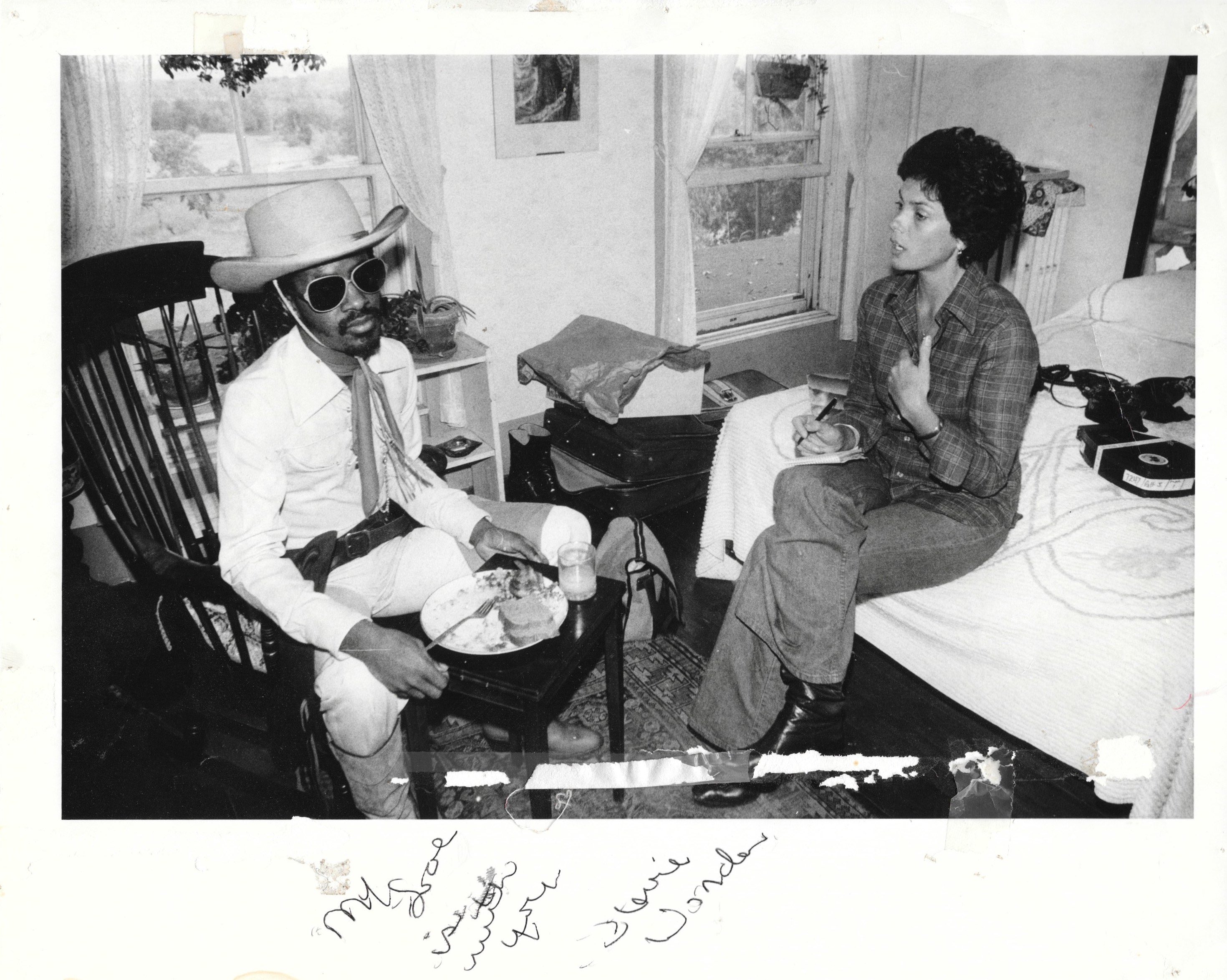Original Publication: Vogue – April, 1981
Call them “women’s” issues or “family” issues—it’s predicted they will be to the ‘80s what Vietnam was to the ‘60s, what consumerism and ecology were to the ‘70s. Here, an urgent report on what’s at stake, what you need to know about the critical questions to be decided by the Reagan administration—decisions that, in effect, will legislate morality and determine if women are to be the economic equals of men
The American woman begins the ‘eighties with a challenging new reality. As the decade dawns, issues of profound concern to women will be debated and decided and we will have a clear choice: to seek legislation that reflects the economic and social patterns of our lives or to stand by and watch the repeal of certain hard-won gains we once thought secure—the right to choose an abortion, for example, and protection against job discrimination by affirmative action programs.
In the next few years, the Reagan administration and the newly reconstituted Congressional leadership will be focusing on issues that deal with our economic security, our career choices and flexibility, our sexual and reproductive freedom. Yet too few of us are informed about the ways our lives might be altered by the decisions. Even fewer of us seem to grasp that our fate more and more rests in the hands of men who are essentially disinterested in women’s rights and that until more of us become politically aware we won’t be able to do much about it.
At the same time, with the passage of the Equal Rights Amendment almost certainly doomed, the forces of the Women’s Movement are regrouping in recognition of the fact that their methods as well as their image have not appealed to the mainstream of American women. There is a new spirit among women leaders, a spirit of reconciliation based on the new principle that women must organize around the issues that bring the largest numbers of us together. Though the ERA and abortion may remain the most visible causes, the largest banners on Pennsylvania Avenue, on Inauguration Day, were those encouraging President Reagan to support the ERA—what is going on behind the scenes right now is more significant: groups of women are forgetting past differences and trying to put the divisiveness of those causes behind them. They are meeting endlessly, getting better organized, forming new coalitions, and cooperating as never before.
We are finally beginning a new era of pragmatism. We are learning that labels really don’t mean much. Hardly anyone admits to being a “women’s libber” anymore. Fine. But that doesn’t mean we don’t want equal rights or that we’re willing to live with economic discrimination. The challenge of the leadership is to demonstrate to the majority of American women that “Women’s Movement” issues are no longer special or rarefied: they shape every woman’s life.
The most pervasive discrimination against women is economic. That simple fact is often obscured in the emotional rhetoric about the ERA and abortion. Today, more than half the adult population of women work—many because they want to, many more because they have to. Only a small minority of women—approximately 14 to 16 percent—live in a traditional nuclear family with the male the sole wage earner. Nevertheless, our laws do not reflect the way our lives have changed. “Our policymakers,” says Carol Bellamy, president of the New York City Council, “continue to make public policy based on a view of a society that does not exist.”
The economic situation of women, however, speaks overwhelmingly of the need for change. While increasing numbers of women have assumed high-level positions in all fields, women still earn only fifty-nine cents to every dollar a man earns. The vast majority of women work in female-segregated jobs that pay less than men receive even for “work of comparable value.” Thus, librarians often earn less than liquor-store clerks, nurses less than ambulance drivers. Ninety percent of American women who work never receive a penny in pension benefits, despite the fact that today they average thirty-four years in the work force. Why? Because women, who often temporarily leave the work force to move with their husbands, or to raise a family, do not stay at one job long enough to qualify for pension benefits. (Most industries do not “vest” employees for pensions until they have been with the company for ten years.) The current Social Security laws, written in 1939, also discriminate against women, and give the most generous benefits to a one-income family with a lifetime marriage—a profile which today fits less than 16 percent of American families. Women pay higher premiums than men for disability insurance and receive lower benefits. The majority of women with children under the age of eighteen work, yet there is no child care established by the government nor any tax incentives for private business to establish day care on its own.
Most alarming of all is the phenomenon that has been dubbed “the feminization of poverty.” Elderly women in America today are the largest poverty group and the fastest growing. Sadly, for a woman, to grow old increasingly means to die penniless and alone. Even more startling is the revelation that between 1968-78 the number of female-headed households increased 54 percent. Many of these families are also poor; and, according to a report by the National Advisory Council on Economic Opportunity, “All other things being equal, if the proportion of poor who are in female-headed families were to increase at the same rate it did from 1967 to 77, they would comprise 100 percent of the poverty population by the year 2000.
What these issues point to is that after more than a decade of agitation for equal rights, women view themselves in a radically different way; but, compared to men, we still earn almost no more than we did ten years ago—and in many cases we earn less. “The support for women and for women’s issues is just a lot of political window dressing,” says Margaret Heckler (Republican, Massachusetts), the senior woman member of the House and founder of the Congresswomen’s Caucus. “When it gets down to decision-makers, they are mostly male, and male-oriented. They genuinely do not understand these issues.”
But those who are the avowed enemies of the Women’s Movement most certainly do. The New Right, which opposes much of the legislation having to do with altering the current laws and policies discriminating against women, is both politicized and highly organized. It is ready to oppose any legislation that hints rightly or wrongly of having the effect of “inducing women into the work force,” despite the fact that women are already there. Paul Weyrich, for example, director of the Committee for the Survival of a Free Congress and an advisor to Pro-Family groups, has said that family issues will be to the ‘eighties what Vietnam was to the ‘sixties, and what consumer and environmental issues were to the ‘seventies. Phyllis Schlafly, who has served as the national chairman of STOP ERA and is the best-known Right to Life leader, is supremely confident her views will prevail. “I think the past election dealt a staggering blow to the Women’s Movement,” Schlafly says. “I think the momentum is going all our way.”
Schlafly, who, ironically, went back to law school in the ‘seventies and maintains a full schedule of traveling, writing, and speaking engagements, is even willing to sound the death knell on the future of the entire women’s struggle for equal rights. “Obviously we’re the wave of the future because we’re the ones having the children,” Schlafly says. “The birthrate is down among women who are opting for a career instead of a home. It’s certainly curtains for their movement.”
“Let’s not kid ourselves,” says Ann Lewis, a longtime liberal champion of women’s rights and aide to Democratic Congresswoman Barbara Mikulski of Maryland. “The gains we have made are neither permanent nor self-perpetuating.”
The current Congress, for example, will be debating a Constitutional amendment to ban abortion, perhaps the most emotionally searing issue for women.
“This human-life amendment is probably the scariest thing that’s happened since I can’t remember when,” says Eleanor Smeal, the president of the National Organization for Women and the married mother of two children. “It’s an amendment which would not only outlaw abortion, but could also outlaw the IUD, low-estrogen birth-control pills—the most common and safe form of the Pill—and the “morning-after” pill. This is a direct frontal attack on major forms of contraception. Most people would have said ten years ago this wouldn’t be possible. Now we have a conservative Senate and President who are for some version of an abortion ban. Women do not know that their right to use the Pill is being voted on when the human-life amendment is being voted on. A lot of people think the issues we are dealing with are removed from them. But every day we deal with ordinary life-and-death issues for ordinary people.”
The Pro-Family movement, aligned on the other side, is no less serious about the importance of banning abortion and making sure it’s banned quickly. “Abortion is not behind us,” says Connie Marshner, a leader of the Pro-Family movement. “It is a top item on many agendas. If Ronald Reagan doesn’t keep his promise to support the Right to Life movement, the same thing will happen to him that happened to Jimmy Carter.”
The other critical issue among those interested in women’s rights is the Equal Rights Amendment. Privately, most traditional feminists will agree the ERA has a shaky future. “You won’t get many women to say it, but it’s true,” says Anne Wexler, Democratic Party leader and former top aide to President Carter. “The level of misinformation about what the Equal Rights Amendment is is so high that we’ve never been able to combat it.”
The ratification of the ERA remains, however, the top priority for all feminist groups, and they are continuing to fight for its passage. As opposed to what many women have been led to believe, the ERA proponents know its passage is more than a merely symbolic act. “If you had ERA,” says Marilyn Heath of the Business and Professional Women’s Clubs, “you could not roll back affirmative action programs which promote women and minorities, for example. You would have to do something about insurance rates which vary for men and women. The ERA is a standard by which courts can measure any law, regulation, legislation. Currently, legal rights for women are different in every state. ERA would mean that, within two years, Congress would have to bring statutes (like those dealing with community-property laws, for example), up to the level of equality, and states would do whatever they must to be sure the ERA is implemented. Without a deadline, there is no method of enforcement. The ERA is the absolute foundation of equality.”
Still, the ERA has an image problem: it’s viewed as a loser. “The ERA is dead,” Carol Bellamy states. “So what do we do? As they say in the labor movement, don’t agonize, organize. We need to form alliances between labor women, elderly women, with homemakers and management women. My view is that women who believe in equal rights have valid goals; our strategies will have to change.”
They are beginning to change already. Today, forward-looking women leaders and a group of both Republican and Democratic members of the House and Senate want to put the whole divisive debate on the ERA and abortion behind them. The new strategy is to organize women around economic issues, to pass legislation that will help the largest number of women where they need it most: in their pocketbooks. The fact is there aren’t that many safeguards for women in the realm of economic security.
“I cannot tell you how many recently divorced or widowed women come into my office hysterical, having found out what the laws really are for the first time,” says Congresswoman Patricia Schroeder (Democrat, Colorado). The laws, for example say that a woman widowed before age sixty, who has never worked, will not be able to touch her husband’s Social Security; and she is usually not entitled to his pension. A military wife divorced after twenty or thirty years of marriage can’t share in her husband’s pension benefits though his promotions may have depended in part on her social performance.
“So many women have drifted through their whole lives thinking they don’t have to worry—they’re protected. They’re not,” says Schroeder. “Then they say they’ve never been a women’s libber and they didn’t understand what the Women’s Movement was about. They thought it was women leaping barricades, screaming obscenities. The problem for the Women’s Movement is to overcome its extremist image.”
The results of last November’s election have made the need for this abundantly clear. “We used to have this test for who our friends were,” says Pat Reuss, Washington-based lobbyist with the Women’s Equity Action League. “Pro-choice, pro-ERA, some form of national child care—you had to talk the ‘party line’. Suddenly we’re finding out there are very few of those true believers so we’re having to broaden our base. We are suddenly having to talk to people who don’t buy our program 100 percent. We’ll find one area where we can work together.” There is a new willingness to cooperate on the part of traditional feminists and some Republican legislators who have never been particularly in the same camp before. Three Republican Senators are introducing a complete women’s economic-equity package that will cover everything from pension reform (Lowering the vesting requirement to five years; arranging for employees to accumulate pension credit by transferring them from job to job) to a proposal to increase the tax credit for day care.
Senator Orrin Hatch, Republican of Utah, a staunch conservative who had led the fight against abortion and the ERA is, on the other hand, holding hearings on equal work for equal pay, and on equal pay for “work of comparable value.” He wants to know why the current laws aren’t working in women’s favor, and what needs to be done to make them work. He is also strongly concerned about sexual harassment on the job and has discussed the problem with women’s groups. He wants his hearings to establish a dialogue with women’s groups and business on all these subjects. If a right-wing Senator like Hatch and feminist groups can work together, it will be a measure of how far both have come.
Interestingly, as the Women’s Movement’s leaders grope to broaden their appeal and improve their effectiveness, a striking new result of their influence can already be seen. In the last election, for the first time, women voted differently from their fathers or husbands. While men voted overwhelmingly for Ronald Reagan, women split their votes evenly between Reagan and Jimmy Carter. Exit polls show the differential may have been based on the women’s understanding of how each candidate stood on peace issues and women’s issues. “If politicians don’t understand there is a major voting block out there willing to articulate votes on issues they feel strongly about, whether peace, ERA, or general hostility or insensitivity to women, they’re a little crazy,” says Carol Bellamy.
Now, as the ‘eighties begin, women Republican leaders especially are counting on President Reagan to respond to the new constituencies. “It’s really going to be up to the President to follow through on his commitment to equal rights” says Congresswoman Heckler. “And it’s going to be up to the women in Congress to pressure him to do so. We must make our case, and early,” It is also up to all of us. The fulfillment of equal rights for women is a commitment that has been made not only by the new administration, but by Congress and both political parties. Whether that commitment is fulfilled is the principal challenge to women in the ‘eighties.
This article is typed from the original material. Please excuse any errors that have escaped final proofreading.





No Comments